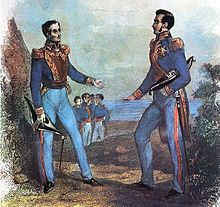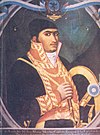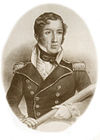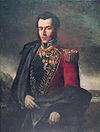Libertadores

Libertadores (Spanish pronunciation: [liβeɾtaˈðoɾes] (![]() listen), Portuguese: [libeɾtaˈdoɾis], "Liberators") were the principal leaders of the Latin American wars of independence from Spain and Portugal. They are named that way in contrast with the Conquistadors.[1]
listen), Portuguese: [libeɾtaˈdoɾis], "Liberators") were the principal leaders of the Latin American wars of independence from Spain and Portugal. They are named that way in contrast with the Conquistadors.[1]
They were largely bourgeois criollos (local-born people of European, mostly of Spanish or Portuguese, ancestry) influenced by liberalism, and in most cases with military training in the metropole (mother country).
List of libertadores[]
Legacy[]
The flags of Venezuela, Colombia and Ecuador follow Francisco de Miranda's design of 1806. Also, Bolivia was named after Bolivar, who in turn was president of Colombia, Peru, Bolivia and twice of Venezuela. San Martín served as "President Protector" of Peru.
In what today is part of Mexico, Guatemala, El Salvador, Honduras, Nicaragua and Costa Rica, Iturbide, a military leader revolted against the Viceroyalty of New Spain, founded an independent nation where he ascended as Emperor Augustin I.
The names of libertadores are used all over South America to name anything from towns and places to institutions and sports clubs. Also, the most prestigious international club football competition in South America is named the Copa Libertadores in their honour.
See also[]
- List of national founders
- Father of the Nation
- Founding Fathers of the United States
- Statues of the Liberators
Bibliography[]
- Robert Harvey. Liberators: Latin America's Struggle for Independence. Woodstock, The Overlook Press, 2000. ISBN 1-58567-072-3
- James Higgins (editor). The Emancipation of Peru: British Eyewitness Accounts, 2014. Online at https://sites.google.com/site/jhemanperu
- Marion Lansing. Liberators and Heroes of South America. Boston, L. C. Page & Co., 1940.
- Irene Nicholson. The Liberators: A Study of Independence Movements in Spanish America. New York, Frederick A. Praeger, 1968.
- Pigna, Felipe (2010). Libertadores de América. Buenos Aires: Planeta. ISBN 978-950-49-2420-3.
References[]
- ^ Pigna, p. 9
- ^ Pigna, pp. 195-272
- ^ Pigna, pp. 135-192
- ^ Jump up to: a b Robert Harvey. Liberators: Latin America's Struggle for Independence. Woodstock, The Overlook Press, 2000. ISBN 1-58567-072-3
- ^ Pigna, p. 55-91
- ^ page 429 Robert Harvey. Liberators: Latin America's Struggle for Independence. Woodstock, The Overlook Press, 2000. ISBN 1-58567-072-3
- ^ Pigna, pp. 93-133
- ^ Lansing, pp. 15-39
- ^ Lansing, pp. 39-59
- ^ Jump up to: a b c Lansing, p. 121
- ^ Pigna, pp. 13-52
- ^ Lansing, pp. 119
- ^ Rezzutti, Paulo (2017). D. Leopoldina, a história não contada: A mulher que arquitetou a independência do Brasil. Leya. p. 223.
- ^ page 511, Robert Harvey. Liberators: Latin America's Struggle for Independence. Woodstock, The Overlook Press, 2000. ISBN 1-58567-072-3
- ^ Lansing, pp. 219
External links[]
| Wikimedia Commons has media related to Libertadores. |
- (in Spanish) "Sucre, Bolívar y San Martín" Argentine Ministry of Economy
- Copa Libertadores
- History of South America
- People of the Spanish American wars of independence
- Age of Enlightenment















